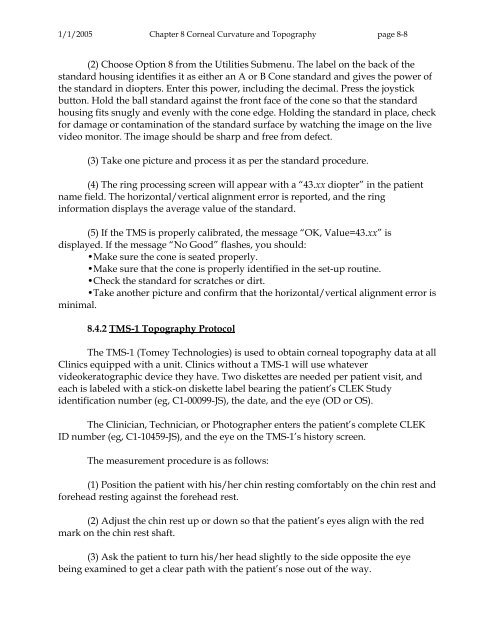OM t of c.iii - Vision Research Coordinating Center - Washington ...
OM t of c.iii - Vision Research Coordinating Center - Washington ...
OM t of c.iii - Vision Research Coordinating Center - Washington ...
Create successful ePaper yourself
Turn your PDF publications into a flip-book with our unique Google optimized e-Paper software.
1/1/2005 Chapter 8 Corneal Curvature and Topography page 8-8<br />
(2) Choose Option 8 from the Utilities Submenu. The label on the back <strong>of</strong> the<br />
standard housing identifies it as either an A or B Cone standard and gives the power <strong>of</strong><br />
the standard in diopters. Enter this power, including the decimal. Press the joystick<br />
button. Hold the ball standard against the front face <strong>of</strong> the cone so that the standard<br />
housing fits snugly and evenly with the cone edge. Holding the standard in place, check<br />
for damage or contamination <strong>of</strong> the standard surface by watching the image on the live<br />
video monitor. The image should be sharp and free from defect.<br />
(3) Take one picture and process it as per the standard procedure.<br />
(4) The ring processing screen will appear with a “43.xx diopter” in the patient<br />
name field. The horizontal/vertical alignment error is reported, and the ring<br />
information displays the average value <strong>of</strong> the standard.<br />
(5) If the TMS is properly calibrated, the message “OK, Value=43.xx” is<br />
displayed. If the message “No Good” flashes, you should:<br />
•Make sure the cone is seated properly.<br />
•Make sure that the cone is properly identified in the set-up routine.<br />
•Check the standard for scratches or dirt.<br />
•Take another picture and confirm that the horizontal/vertical alignment error is<br />
minimal.<br />
8.4.2 TMS-1 Topography Protocol<br />
The TMS-1 (Tomey Technologies) is used to obtain corneal topography data at all<br />
Clinics equipped with a unit. Clinics without a TMS-1 will use whatever<br />
videokeratographic device they have. Two diskettes are needed per patient visit, and<br />
each is labeled with a stick-on diskette label bearing the patient’s CLEK Study<br />
identification number (eg, C1-00099-JS), the date, and the eye (OD or OS).<br />
The Clinician, Technician, or Photographer enters the patient’s complete CLEK<br />
ID number (eg, C1-10459-JS), and the eye on the TMS-1’s history screen.<br />
The measurement procedure is as follows:<br />
(1) Position the patient with his/her chin resting comfortably on the chin rest and<br />
forehead resting against the forehead rest.<br />
(2) Adjust the chin rest up or down so that the patient’s eyes align with the red<br />
mark on the chin rest shaft.<br />
(3) Ask the patient to turn his/her head slightly to the side opposite the eye<br />
being examined to get a clear path with the patient’s nose out <strong>of</strong> the way.
















